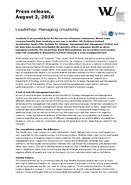Leadership: Managing creativity
Creativity is an essential factor for the success of business enterprises. Almost every company benefits from creativity in one way or another. WU Professor Gerhard Speckbacher, head of the Institute for Strategic Management and Management Control, and his team have recently investigated the question of how companies should go about managing creativity. The researchers found that employees are not at their most creative when left completely to themselves, but that creativity is a key management task.
When people hear the word “creativity,” they usually think of artists and genius scientists and their sometimes eccentric idiosyncrasies. Friedrich Schiller, for instance, is reputed to have drawn creative inspiration from the smell of rotting apples. In a business context, however, creativity is almost never about spectacular flashes of inspiration. In fact, creativity tends to be part of the daily business of companies and is usually a team effort. This means that supervisors are faced with the challenging task of managing their teams in a way that enables the team members to think creatively and out of the box while at the same time functioning well as a team and producing ideas that are useful and feasible for the business. In his research, WU Professor Gerhard Speckbacher, head of WU’s Department of Strategy and Innovation and the Institute for Strategic Management and Management Control, looks at the question of how teams should be managed and supervised for optimum performance both in terms of creativity and the fulfillment of business targets.
A look at real-life management practice
As part of several studies conducted at the Institute for Strategic Management and Management Control over the past five years, over 1,000 people working at several hundred companies in many different industries were interviewed to find out more about these questions. The supervisors were asked about the management instruments they used, and the employees shared their perceptions of their supervisors and their management styles. Gerhard Speckbacher and his fellow researchers also collected data about different aspects of team composition. To complement these findings, an additional study was carried out to find out how the supervisors rate their teams with regard to creativity. Following statistical analyses of the data obtained, various hypotheses were tested, for instance regarding the pros and cons of different management styles and the effects of predefined targets or rules on creativity in the team, seen as the generation of new ideas that are useful for the company.
The constellation makes the difference
The results show that, contrary to widely held beliefs, clearly defined rules, norms, and targets are very important for the creative process in a business context. Whether these rules, norms, and targets have a positive or a negative impact on team creativity, however, depends on the supervisor’s management style. Supervisors should not only inspire and intellectually stimulate their team members, but the targets and evaluation methods they use should be oriented towards development rather than control. The use of developmental evaluation, that is feedback aimed at developing the team’s capabilities rather than controlling the degree of target achievement, can avoid the potential negative effects of targets and rules on the team’s intrinsic motivation and creative confidence.
A better balance
This means that the key to promoting creativity that benefits business enterprises is not so much allowing for additional freedom, for instance at companies like Google, which for a time experimented with giving employees one day per week for being creative. “To stimulate the free flow of useful creative ideas at a company, it is by no means necessary to abolish rules and targets. Quite to the contrary: Rules and targets that are communicated and justified in a clear manner are very important, but they have to play a different role. They help supervisors define spaces and directions for the team members to give free rein to their creativity and they help to develop the team’s skills in a structured manner. For many supervisors, however, this management style is much more challenging than the common “plan-do-check-act” approach to target-based management,” explains Professor Speckbacher.
Contact:
Anna Maria Schwendinger
PR Manager
Tel: + 43-1-31336 ext. 5478
Email: anna.schwendinger@wu.ac.at
wu.ac.at

